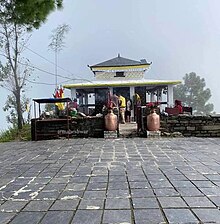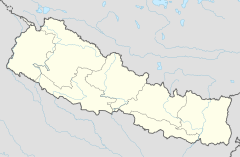Draft:Kaal Bhairav Bhairabsthan Mandir
| This is a draft article. It is a work in progress open to editing by anyone. Please ensure core content policies are met before publishing it as a live Wikipedia article. Find sources: Google (books · news · scholar · free images · WP refs) · FENS · JSTOR · TWL Last edited by Jamiebuba (talk | contribs) 2 days ago. (Update)
Finished drafting? or |
This article has multiple issues. Please help improve it or discuss these issues on the talk page. (Learn how and when to remove these messages)
|
| Kaal Bhairav Temple | |
|---|---|
 View of Kaal Bhairav Temple in Balewa | |
| Religion | |
| Affiliation | Hinduism |
| District | Baglung District |
| Deity | Kaal Bhairav (Lord Shiva) |
| Festival | Dashain, Krishna Paksha Ashtami, Harelo Festival, Shrawan Sankranti |
| Governing body | Guthi and Bhairavsthan Management Committee |
| Location | |
| Location | Balewa, Baglung, Nepal |
| State | Gandaki Province |
| Country | Nepal |
| Geographic coordinates | 28°12′40″N 83°37′01″E / 28.2112°N 83.6170°E |
| Architecture | |
| Style | Pagoda Hindu Temple Architecture |
| Date established | 1724 AD, 1780 BS |
Kaal Bhairav Temple, Balewa is a Hindu temple in Balewa, Baglung District, Nepal. It is dedicated to Kaal Bhairav, a fierce manifestation of Shiva. The temple, situated at an altitude of 2,200 meters , offers panoramic views of the Himalayas, including Dhaulagiri, Machhapuchhre, and Annapurna. It is considered an important religious and cultural landmark in the region, with its proximity to the Kali Gandaki River, which eventually merges with the sacred Ganges.
Location
[edit]The Kaal Bhairav Temple is in Amalachour Ward No. 12 of Baglung Municipality, in the Baglung District of Nepal. This area is approximately 17 kilometers south of Baglung Bazaar, near the Maladhunga checkpoint. The temple's elevated position at 2,200 meters (7,218 feet) above sea level offers visitors panoramic views of the surrounding Himalayas, including Dhaulagiri, Machhapuchhre, and Annapurna.
Balewa is accessible via road from major cities in Nepal. Travelers can reach Baglung Bazaar and then proceed to Balewa by local transportation options such as buses or private vehicles. The temple is also accessible via a cable car from Kushma, Parbat, which crosses the Kali Gandaki River and connects to Narayansthan.
Nearby landmarks include Kalika Bhagawati Mandir, Bhakunde View Tower, Jaimini Dham.
History and mythology
[edit]Origin of Bhairav
[edit]According to local mythology, the Bhairav deity originally resided in Palpa, Nepal. However, a conflict arose between two Bhairav brothers, leading the deity to leave Palpa in the form of a fire flame and journey towards Balewa. Locals, seeking guidance from a Lama Jhankri (spiritual healer), were instructed to build a temple and perform regular worship in honor of Kaal Bhairav.
Initially, the self-manifested idol was buried underground, as direct visual contact with the idol was considered inauspicious. However, over time, devotees felt the need for a physical idol to enhance worship practices.
Arrival of the idol from Rameshwaram
[edit]In 2013, a new idol of Kaal Bhairav was installed at the Kaal Bhairav Temple. The idol was crafted from granite, a stone renowned in South India for its use in deity sculptures, especially in regions celebrated for their ancient temples.

The idol was sourced from Rameshwaram, a pilgrimage site in Madras, Tamil Nadu. Local devotees Chitralal Khadka and Chandra Prasad Acharya, from Amalachour, personally funded the project and provided various puja items and decorative materials to ensure proper rituals were performed.
The Prana Pratistha (consecration ceremony) of the idol was conducted on Panchami Tithi, Krishna Paksha, on 30 April 2013. On the eve of the ceremony, the idol was submerged overnight in the holy Kali Gandaki River at Jaimini Dham (also known as Jimirey Ghat), a sacred site believed to be the meditation spot of Rishi Jaimini from the pre-Mahabharata period. Devotees gathered on the riverbank, engaging in continuous bhajan (devotional singing) throughout the night.
On the morning of 30 April, the idol underwent a ceremonial Abhishekam (ritual bathing) using sacred substances, including water from the Ganges River, milk, yogurt, honey, ghee, sugar, coconut water, rose water, various fruit juices, sesame seeds, and flowers. After the purification rites, the idol was carried in a grand Jatra (procession) from the riverbank to the temple. A multitude of devotees accompanied the procession, chanting and singing hymns, marking an unprecedented gathering in the temple's history.
Architecture and design
[edit]The Kaal Bhairav Temple is an example of traditional Nepalese pagoda-style architecture, characterized by its tiered, multi-roofed structure and intricate wooden carvings with its main deity and entrance facing south, a direction associated with Lord Kaal Bhairav in Hindu scriptures.
Renovation and structural evolution
[edit]- 1780 BS – The original temple had a thatched roof (Khar).
- 1995 AD – The temple was renovated with a copper roof by Khadka Bahadur Pathak.
- 2047 BS – Under the directive of King Birendra, further government funding was allocated for structural improvements.
Worship
[edit]The daily puja (worship rituals) at the temple are traditionally performed by the Thakuri lineage family. The temple is open throughout the week, but Tuesdays and Saturdays are considered the most auspicious days for worship.
To ensure its long-term sustainability, 13 ropanis of land have been allocated to the Guthi and temple management committee, which oversees operations under the guidance of the Central Guthi Office.
Festivals and rituals
[edit]Major rituals and celebrations
[edit]- Tarbar Dance – A traditional martial dance performed during Dashain and Mahanavami, symbolizing the warrior spirit of the Thakuri and Kshatriya communities.
- Harelo Festival – Celebrated annually on the first Tuesday of Bhadra, invoking blessings for rainfall and agricultural prosperity.
- Rako Falne (Flame Offering Ritual) – Observed on Shrawan Sankranti, involving fire offerings at the Kali Gandaki River to ward off evil spirits.
- Pancha Bali (Animal Sacrifice Rituals) – Conducted during Dashain, involving the offering of buffalo, goat, sheep, Chicken, and pigeon** as per Hindu traditions.
Pilgrimage and devotees
[edit]The Kaal Bhairav Temple attracts thousands of pilgrims from Baglung, Parbat, Kaski, Kathmandu, and Tamil Nadu, India. It is particularly visited during Ashwin (September–October) and on Krishna Paksha Ashtami, a sacred day dedicated to Lord Bhairav.
Prominent Visitors and Government Recognition
[edit]The temple has drawn notable dignitaries, ministers, and entrepreneurs, including Chandra Prasad Dhakal, Chairman of IME Group. The Nepalese government and private organizations have contributed to the temple’s preservation and development.
References
[edit]

